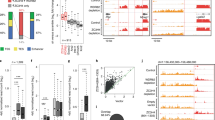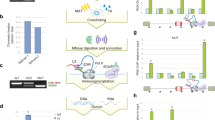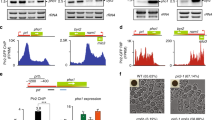Abstract
When targeting promoter regions, small interfering RNAs (siRNAs) trigger a previously proposed pathway known as transcriptional gene silencing by promoting heterochromatin formation. Here we show that siRNAs targeting intronic or exonic sequences close to an alternative exon regulate the splicing of that exon. The effect occurred in hepatoma and HeLa cells with siRNA antisense strands designed to enter the silencing pathway, suggesting hybridization with nascent pre-mRNA. Unexpectedly, in HeLa cells the sense strands were also effective, suggesting that an endogenous antisense transcript, detectable in HeLa but not in hepatoma cells, acts as a target. The effect depends on Argonaute-1 and is counterbalanced by factors favoring chromatin opening or transcriptional elongation. The increase in heterochromatin marks (dimethylation at Lys9 and trimethylation at Lys27 of histone H3) at the target site, the need for the heterochromatin-associated protein HP1α and the reduction in RNA polymerase II processivity suggest a mechanism involving the kinetic coupling of transcription and alternative splicing.
This is a preview of subscription content, access via your institution
Access options
Subscribe to this journal
Receive 12 print issues and online access
$189.00 per year
only $15.75 per issue
Buy this article
- Purchase on Springer Link
- Instant access to full article PDF
Prices may be subject to local taxes which are calculated during checkout







Similar content being viewed by others
References
Kornblihtt, A.R. Chromatin, transcript elongation and alternative splicing. Nat. Struct. Mol. Biol. 13, 5–7 (2006).
Lorincz, M.C., Dickerson, D.R., Schmitt, M. & Groudine, M. Intragenic DNA methylation alters chromatin structure and elongation efficiency in mammalian cells. Nat. Struct. Mol. Biol. 11, 1068–1075 (2004).
Batsché, E., Yaniv, M. & Muchardt, C. The human SWI/SNF subunit Brm is a regulator of alternative splicing. Nat. Struct. Mol. Biol. 13, 22–29 (2006).
Schor, I.E., Rascovan, N., Pelisch, F., Allo, M. & Kornblihtt, A.R. Neuronal cell depolarization induces intragenic chromatin modifications affecting NCAM alternative splicing. Proc. Natl. Acad. Sci. USA 106, 4325–4330 (2009).
Kim, D.H., Villeneuve, L.M., Morris, K.V. & Rossi, J.J. Argonaute-1 directs siRNA-mediated transcriptional gene silencing in human cells. Nat. Struct. Mol. Biol. 13, 793–797 (2006).
Morris, K.V., Chan, S.W., Jacobsen, S.E. & Looney, D.J. Small interfering RNA-induced transcriptional gene silencing in human cells. Science 305, 1289–1292 (2004).
Suzuki, K. et al. Closed chromatin architecture is induced by an RNA duplex targeting the HIV-1 promoter region. J. Biol. Chem. 283, 23353–23363 (2008).
Kuramochi-Miyagawa, S. et al. DNA methylation of retrotransposon genes is regulated by Piwi family members MILI and MIWI2 in murine fetal testes. Genes Dev. 22, 908–917 (2008).
González, S., Pisano, D.G. & Serrano, M. Mechanistic principles of chromatin remodeling guided by siRNAs and miRNAs. Cell Cycle 7, 2601–2608 (2008).
Zhang, M.X. et al. Effect of 27nt small RNA on endothelial nitric-oxide synthase expression. Mol. Biol. Cell 19, 3997–4005 (2008).
Zhang, M.X. et al. Biogenesis of short intronic repeat 27-nucleotide small RNA from endothelial nitric-oxide synthase gene. J. Biol. Chem. 283, 14685–14693 (2008).
Tay, Y., Zhang, J., Thomson, A.M., Lim, B. & Rigoutsos, I. MicroRNAs to Nanog, Oct4 and Sox2 coding regions modulate embryonic stem cell differentiation. Nature (2008).
Kim, D.H., Saetrom, P., Snove, O. Jr. & Rossi, J.J. MicroRNA-directed transcriptional gene silencing in mammalian cells. Proc. Natl. Acad. Sci. USA 105, 16230–16235 (2008).
de la Mata, M. et al. A slow RNA polymerase II affects alternative splicing in vivo. Mol. Cell 12, 525–532 (2003).
Schwarz, D.S. et al. Asymmetry in the assembly of the RNAi enzyme complex. Cell 115, 199–208 (2003).
Kim, D.H. et al. Synthetic dsRNA Dicer substrates enhance RNAi potency and efficacy. Nat. Biotechnol. 23, 222–226 (2005).
Persengiev, S.P., Zhu, X. & Green, M.R. Nonspecific, concentration-dependent stimulation and repression of mammalian gene expression by small interfering RNAs (siRNAs). RNA 10, 12–18 (2004).
Weinberg, M.S. et al. The antisense strand of small interfering RNAs directs histone methylation and transcriptional gene silencing in human cells. RNA 12, 256–262 (2006).
Han, J., Kim, D. & Morris, K.V. Promoter-associated RNA is required for RNA-directed transcriptional gene silencing in human cells. Proc. Natl. Acad. Sci. USA 104, 12422–12427 (2007).
Meister, G. et al. Human Argonaute2 mediates RNA cleavage targeted by miRNAs and siRNAs. Mol. Cell 15, 185–197 (2004).
Janowski, B.A. et al. Involvement of AGO1 and AGO2 in mammalian transcriptional silencing. Nat. Struct. Mol. Biol. 13, 787–792 (2006).
de la Mata, M. & Kornblihtt, A.R. RNA polymerase II C-terminal domain mediates regulation of alternative splicing by SRp20. Nat. Struct. Mol. Biol. 13, 973–980 (2006).
Tong, W., Kulaeva, O.I., Clark, D.J. & Lutter, L.C. Topological analysis of plasmid chromatin from yeast and mammalian cells. J. Mol. Biol. 361, 813–822 (2006).
Wang, G., Liu, T., Wei, L.N., Law, P.Y. & Loh, H.H. DNA methylation-related chromatin modification in the regulation of mouse delta-opioid receptor gene. Mol. Pharmacol. 67, 2032–2039 (2005).
Yokoyama, R., Pannuti, A., Ling, H., Smith, E.R. & Lucchesi, J.C. A plasmid model system shows that Drosophila dosage compensation depends on the global acetylation of histone H4 at lysine 16 and is not affected by depletion of common transcription elongation chromatin marks. Mol. Cell. Biol. 27, 7865–7870 (2007).
Blau, J. et al. Three functional classes of transcriptional activation domain. Mol. Cell. Biol. 16, 2044–2055 (1996).
Kubicek, S. et al. Reversal of H3K9me2 by a small-molecule inhibitor for the G9a histone methyltransferase. Mol. Cell 25, 473–481 (2007).
Cam, H.P., Chen, E.S. & Grewal, S.I. Transcriptional scaffolds for heterochromatin assembly. Cell 136, 610–614 (2009).
Moazed, D. Small RNAs in transcriptional gene silencing and genome defence. Nature 457, 413–420 (2009).
Umlauf, D., Goto, Y. & Feil, R. Site-specific analysis of histone methylation and acetylation. Methods Mol. Biol. 287, 99–120 (2004).
Kapranov, P. et al. RNA maps reveal new RNA classes and a possible function for pervasive transcription. Science 316, 1484–1488 (2007).
Klinck, R. et al. Multiple alternative splicing markers for ovarian cancer. Cancer Res. 68, 657–663 (2008).
Kim, V.N., Han, J. & Siomi, M.C. Biogenesis of small RNAs in animals. Nat. Rev. Mol. Cell Biol. 10, 126–139 (2009).
Okamura, K. & Lai, E.C. Endogenous small interfering RNAs in animals. Nat. Rev. Mol. Cell Biol. 9, 673–678 (2008).
Tam, O.H. et al. Pseudogene-derived small interfering RNAs regulate gene expression in mouse oocytes. Nature 453, 534–538 (2008).
Watanabe, T. et al. Endogenous siRNAs from naturally formed dsRNAs regulate transcripts in mouse oocytes. Nature 453, 539–543 (2008).
Yang, N. & Kazazian, H.H. Jr. L1 retrotransposition is suppressed by endogenously encoded small interfering RNAs in human cultured cells. Nat. Struct. Mol. Biol. 13, 763–771 (2006).
Schwartz, J.C. et al. Antisense transcripts are targets for activating small RNAs. Nat. Struct. Mol. Biol. 15, 842–848 (2008).
Morris, K.V., Santoso, S., Turner, A.M., Pastori, C. & Hawkins, P.G. Bidirectional transcription directs both transcriptional gene activation and suppression in human cells. PLoS Genet. 4, e1000258 (2008).
Haussecker, D. & Proudfoot, N.J. Dicer-dependent turnover of intergenic transcripts from the human beta-globin gene cluster. Mol. Cell. Biol. 25, 9724–9733 (2005).
Tufarelli, C. et al. Transcription of antisense RNA leading to gene silencing and methylation as a novel cause of human genetic disease. Nat. Genet. 34, 157–165 (2003).
Yu, W. et al. Epigenetic silencing of tumour suppressor gene p15 by its antisense RNA. Nature 451, 202–206 (2008).
Rinn, J.L. et al. Functional demarcation of active and silent chromatin domains in human HOX loci by noncoding RNAs. Cell 129, 1311–1323 (2007).
Kadener, S. et al. Antagonistic effects of T-Ag and VP16 reveal a role for RNA pol II elongation on alternative splicing. EMBO J. 20, 5759–5768 (2001).
Nogués, G., Kadener, S., Cramer, P., Bentley, D. & Kornblihtt, A.R. Transcriptional activators differ in their abilities to control alternative splicing. J. Biol. Chem. 277, 43110–43114 (2002).
Cramer, P. et al. Coupling of transcription with alternative splicing: RNA pol II promoters modulate SF2/ASF and 9G8 effects on an exonic splicing enhancer. Mol. Cell 4, 251–258 (1999).
Acknowledgements
We thank P. Bertucci, M. Blaustein, F. Pelisch, M. Muñoz, A. Srebrow, G. Risso, L.G. Acuña, M.G. Herz, N. Tilgner, I. Listerman, M. Bühler, J. Martínez, K. Neugebauer and K. Morris for their support and useful discussions; and Boehringer Ingelheim Pharmaceuticals (Biomolecular Screening, Department of Medicinal Chemistry) for the gift of BIX-01294. This work was supported by grants to A.R.K. from the Fundación Antorchas, the Agencia Nacional de Promoción de Ciencia y Tecnología of Argentina, the University of Buenos Aires and the European Alternative Splicing Network. S.A.E., R.K. and B.C. acknowledge support from Genome Canada and Genome Quebec. M.A. is the recipient of a fellowship and A.R.K. is a career investigator from the Consejo Nacional de Investigaciones Científicas y Técnicas of Argentina. B.C. holds a Canada Research Chair in functional genomics. A.R.K. is an international research scholar of the Howard Hughes Medical Institute.
Author information
Authors and Affiliations
Contributions
M.A. proposed, designed and conducted most of the experiments and prepared the manuscript; V.B., J.P.F., E.P., I.S. and M.d.l.M. conducted some experiments; E.A., M.P. and E.E. conducted the bioinformatics analysis; S.A.E., R.K. and B.C. conducted the PCR panel experiment; and A.R.K. coordinated the work and prepared the manuscript.
Corresponding author
Supplementary information
Supplementary Text and Figures
Supplementary Figures 1–5, Supplementary Tables 1 and 2 and Supplementary Methods (PDF 568 kb)
Rights and permissions
About this article
Cite this article
Alló, M., Buggiano, V., Fededa, J. et al. Control of alternative splicing through siRNA-mediated transcriptional gene silencing. Nat Struct Mol Biol 16, 717–724 (2009). https://doi.org/10.1038/nsmb.1620
Received:
Accepted:
Published:
Issue Date:
DOI: https://doi.org/10.1038/nsmb.1620
This article is cited by
Elongation roadblocks mediated by dCas9 across human genes modulate transcription and nascent RNA processing
Nature Structural & Molecular Biology (2023)
The physiology of alternative splicing
Nature Reviews Molecular Cell Biology (2023)
Functions of HP1 proteins in transcriptional regulation
Epigenetics & Chromatin (2022)
The SWI/SNF subunit BRG1 affects alternative splicing by changing RNA binding factor interactions with nascent RNA
Molecular Genetics and Genomics (2022)
Changes in nuclear and cytoplasmic microRNA distribution in response to hypoxic stress
Scientific Reports (2019)



